Minnesota Employment Demographics
The Minnesota occupational health and safety indicators are surveillance tools created to measure and track different aspects of the health and safety of Minnesota workers. Surveillance of occupational health and safety through these indicators will provide useful information and data for those who create new workplace interventions and injury/illness prevention programs. They will also provide information and data for evaluation of current and ongoing health and safety programs. Finally, these indicators can help furnish data and information for the prioritization of activities and funding as well as justification for the allocation of limited resources.
Demographics
This demographic indicator describes various aspects of Minnesota’s employed population. Data on the numbers and other characteristics of the employed population are available from a variety of sources. The Minnesota Department of Employment and Economic Development (DEED), for example, has data on the most recent employment statistics, employment projections, wages, and many other aspects of employment. For this Indicator, data from the U.S. Bureau of Labor Statistics (BLS) Geographic Profiles of Employment and Unemployment was used to describe Minnesota’s working population, age 16 and older. The Geographic profiles are compiled from the Current Population Survey (CPS). The CPS is a monthly survey of households that is conducted by the BLS to provide data on the labor force, employment, unemployment, persons not in the labor force, hours of work, earnings, and other demographic and labor force characteristics.
In 2014 over 2.8 million Minnesotans age 16 and older reported for work on a daily basis. The unemployment rate for Minnesota in 2014 was 4.0%. Of the 2.8 million individuals working in Minnesota in 2014, 6.1% were self-employed. 21% of the employed populations were part-time employees, 36% of the employed population worked fewer than 39 hours in a week. Of the 2.8 million working individuals, 52% were male and 48% were female. 1.7% of the employed population was between the ages of 16 and 17, 93% of the employed population was between 18 and 64 years old, and the remaining 4.9% were 65 years of age or more. Of the 2014 Minnesota working population, 89.5% were white, 4.5% were black, and 6% were of another race/ethnicity.
The graphs and tables below show the proportion of workers employed in various types of industries in 2011, as well as the rates and trends of employment in Minnesota during 2000-2014.
Percent of employees by industrial category for the year 2014
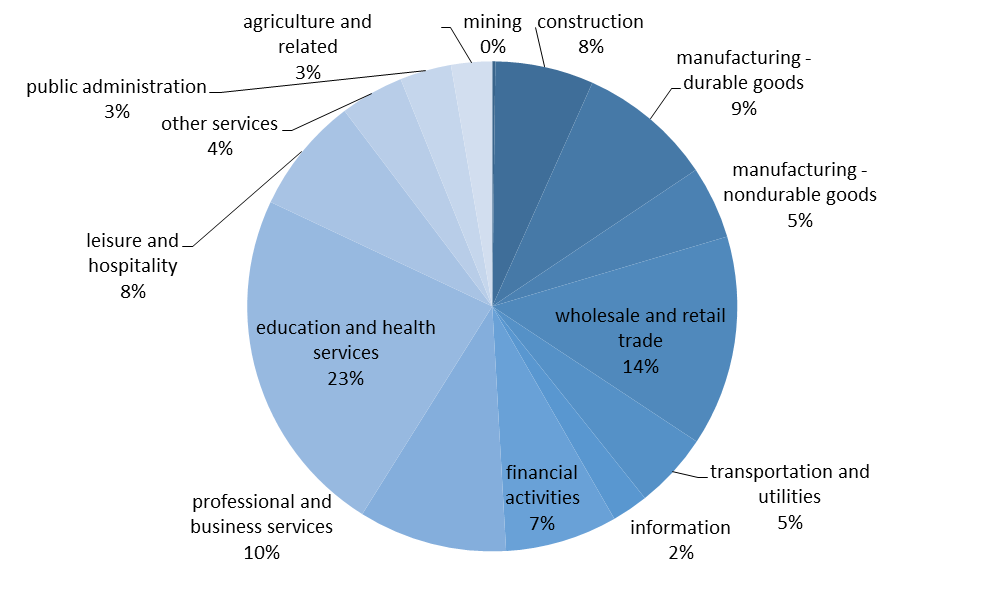
Minnesota Unemployment Rate (%) During 2000 to 2014
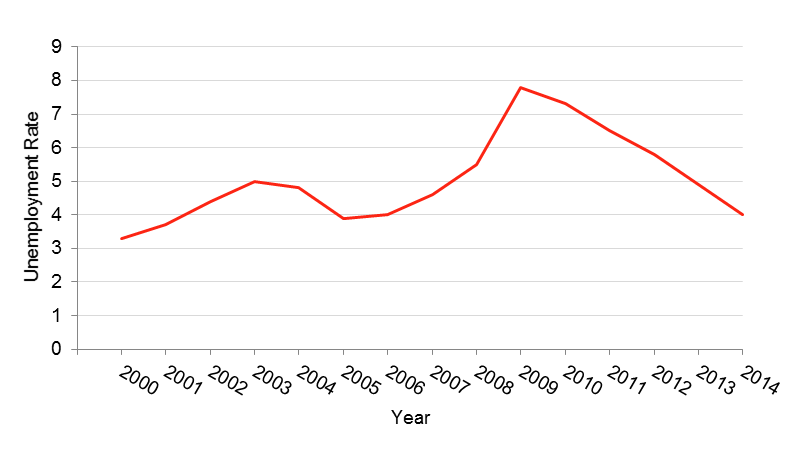
Hours Worked per Week by Minnesota Employed Civilians Greater than 15 years of Age
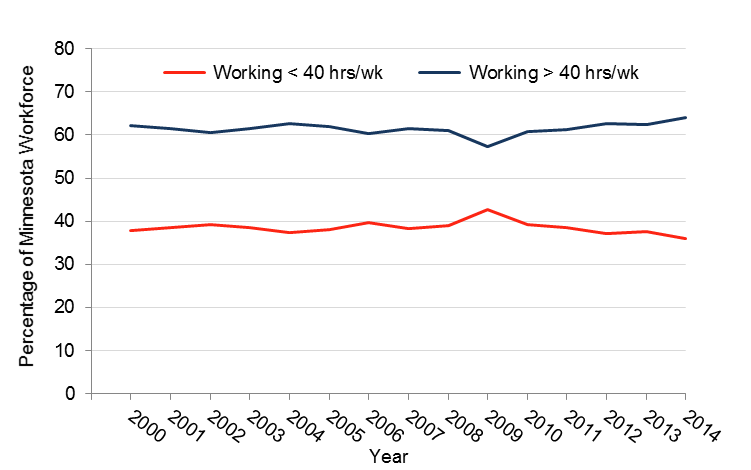
Gender of Minnesota Employed Civilians Greater than 15 years of Age
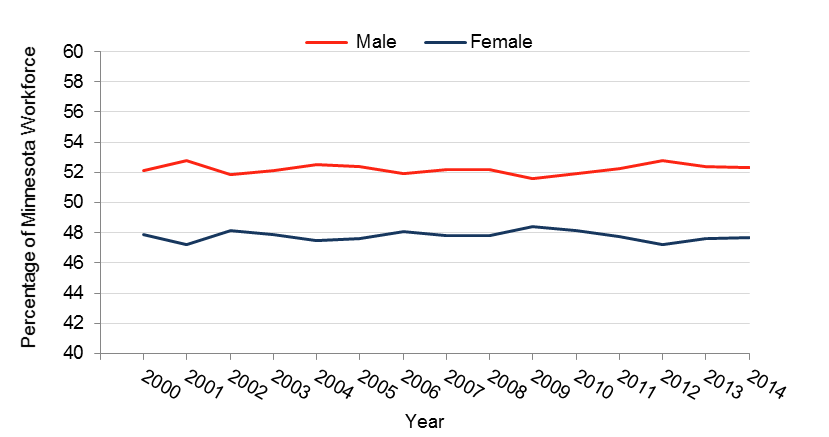
Age Groups of Minnesota Employed Civilian Population
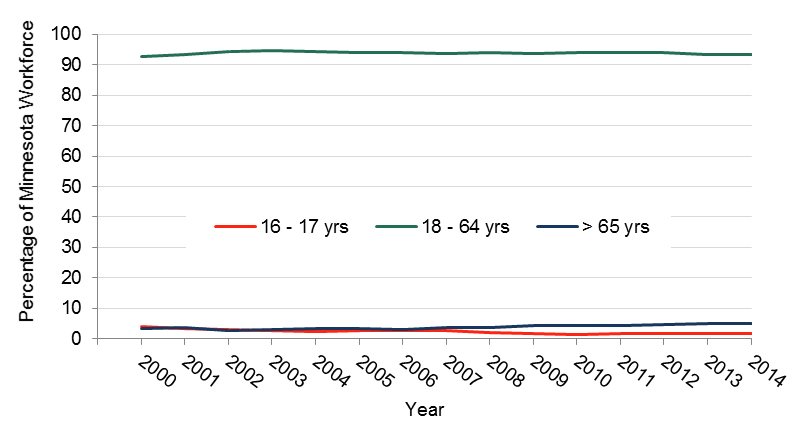
| year | Number Employed (millions) |
Unemployment Rate |
Self-employed (%) |
Employed Part-time (%) |
Working <40 Hrs/wk (%) |
Working ≥40 Hrs/wk (%) |
| 2000 | 2.65 | 3.3 | 8.1 | 19.3 | 37.8 | 62.2 |
| 2001 | 2.71 | 3.7 | 9.4 | 21.7 | 38.6 | 61.4 |
| 2002 | 2.79 | 4.4 | 8.8 | 23.0 | 39.4 | 60.7 |
| 2003 | 2.78 | 5.0 | 8.0 | 21.7 | 38.6 | 61.4 |
| 2004 | 2.80 | 4.8 | 8.0 | 21.8 | 37.3 | 62.7 |
| 2005 | 2.82 | 3.9 | 7.4 | 22.5 | 38.0 | 62.0 |
| 2006 | 2.81 | 4.0 | 7.3 | 22.5 | 39.6 | 60.4 |
| 2007 | 2.77 | 4.6 | 7.0 | 22.4 | 38.4 | 61.6 |
| 2008 | 2.73 | 5.5 | 6.6 | 21.6 | 38.9 | 61.0 |
| 2009 | 2.70 | 7.8 | 6.3 | 23.2 | 42.7 | 57.3 |
| 2010 | 2.72 | 7.3 | 6.2 | 23.2 | 40.2 | 60.8 |
| 2011 | 2.76 | 6.5 | 6.4 | 23.2 | 38.6 | 62.7 |
| 2012 | 2.78 | 5.8 | 6.5 | 21.9 | 37.2 | 62.7 |
| 2013 | 2.82 | 4.9 | 5.8 | 22.2 | 37.6 | 62.4 |
| 2014 | 2.85 | 4.0 | 6.1 | 21.3 | 35.9 | 64.1 |
| Year | Age 16-17 (%) |
Age 18 - 64 (%) |
Age 65+ (%) |
Female (%) |
Male (%) |
White (%) |
Black (%) |
Other Race (%) |
Hispanic (%) |
| 2000 | 3.9 | 92.8 | 3.3 | 47.9 | 52.1 | 94.1 | 2.9 | 3.0 | n/a |
| 2001 | 3.3 | 93.4 | 3.4 | 47.2 | 52.8 | 94.5 | 2.5 | 3.0 | n/a |
| 2002 | 3.0 | 94.2 | 2.8 | 48.2 | 51.8 | 93.9 | 2.6 | 3.5 | 2.9 |
| 2003 | 2.6 | 94.7 | 2.9 | 47.9 | 52.1 | 92.8 | 3.0 | 4.2 | 2.9 |
| 2004 | 2.3 | 94.2 | 3.5 | 47.5 | 52.5 | 91.6 | 2.9 | 5.4 | 2.7 |
| 2005 | 2.6 | 94.2 | 3.3 | 47.6 | 52.4 | 91.4 | 2.7 | 5.9 | 3.3 |
| 2006 | 2.8 | 94.1 | 3.2 | 48.1 | 51.9 | 91.3 | 3.4 | 5.3 | 3.9 |
| 2007 | 2.6 | 93.6 | 3.8 | 47.8 | 52.2 | 91.1 | 3.5 | 5.4 | 4.0 |
| 2008 | 2.1 | 94.1 | 3.8 | 47.8 | 52.2 | 90.8 | 3.6 | 5.6 | 3.6 |
| 2009 | 1.8 | 93.8 | 4.3 | 48.4 | 51.6 | 92.1 | 3.2 | 4.7 | 3.3 |
| 2010 | 1.5 | 94.0 | 4.5 | 48.1 | 51.9 | 92.5 | 3.2 | 4.3 | 3.4 |
| 2011 | 1.8 | 93.8 | 4.3 | 47.7 | 52.2 | 92.4 | 3.1 | 4.3 | 3.9 |
| 2012 | 1.6 | 93.7 | 4.7 | 47.2 | 52.8 | 89.3 | 3.9 | 6.7 | 3.7 |
| 2013 | 1.7 | 93.2 | 5.1 | 47.6 | 52.4 | 88.6 | 4.3 | 7.1 | 4.3 |
| 2014 | 1.7 | 93.5 | 4.9 | 47.7 | 52.3 | 89.4 | 4.6 | 5.9 | 4.4 |